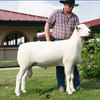Breeds Flashcards
6 breeds that make up 3/4 of the sheep industry
- Delaine Merino
- Hampshire
- Rambouillet
- Romney
- Southdown
- Suffolk
What are the 7 ram breeds? Which are most popular?
- Hampshire
- Suffolk
- Shropshire
- Oxford
- Cheviot
- Montadale
- Southdown
- Hampshire
- Suffolk
What are the 5 dual-purpose breeds?
- Columbia
- Dorset
- Dorper
- Lincoln
- Romney
What are the 12 ewe breeds?
- Merino
- Rambouillet
- Tunis
- Debouillet
- Corriedale
- Targhee
- Finnsheep
- Border Leister
- Polypay
- Panama
- Katahdin
- Romanov
Characteristics of ewe breeds (7)
- Prolificacy
- Wool
- Milking
- Fertility
- Adaptability
- Medium size
- Hardiness
A nonpurebred animal resembling and having the majority of its genetics from one breed
Grade
An animal sired by a male of one breed and out of a dam of another breed
Crossbred
An animal whose sire and dam are of the same breed and their ancestors were of the same breed also
Purebred
A group of animals of common origin that have certain distinguishing characteristics and are capable of transmitting these characteristics to their offspring in a uniform manner
Breed
An ideal or standard of perfection, including all the characteristics of an animal that makes it better suited for a specific purpose or use
Type
35-40% of U.S. sheep are
Fine wool breeds
Advantages of fine wool breeds (3)
- Adaptable to hot/cold climates
- Breed throughout the year
- Great flocking instinct
Disadvantages of fine wool breeds (4)
- Slow growth
- Light muscling
- Excessive hoof growth in wet areas
- Fleece rot in wet areas
5 Hair Type breeds
Barbados Blackbelly
Dorper
White Dorper
Katahdin
St. Croix
9 Meat type breeds
- Hampshire
- Suffolk
- Southdown
- Shropshire
- Dorset
- Cheviot
- Montadale
- Oxford
- Texel
Long Wool Breeds (5)
Romney
Lincoln
Cotswold
Leicester
Finn
Advantages of long wool breeds (4)
- Large size (Lincoln - biggest; Romney - smallest)
- Fast growing lambs
- Milking ability
- Adapted to high rainfall
Disadvantages of Long wool breeds (2)
- NOT heat-tolerant
- Low quality wool
Medium Wool Breeds (8)
PPRTECCT
- Columbia
- Corriedale
- Targhee
- Panama
- Polypay
- Romanov
- Tunis
- East Friesian
Fine Wool Breeds (5)
- Rambouillet
- Merino
- Cormo
- Debouillet
- Booroola Merino
Merinos originated in _____.
Spain
Facts about Merino (4)
- Size
- Wool grade
- Shrinkage
- Prolificacy
- Fairly upstanding (but less than Rambouillet); Small frame size
- Fine wool grade
- 45-65% shrinkage
- Prolificacy: 115-120%
Disadvantages of Merinos (3)
- Slow growth
- Small
- Poor carcass traits

Merino
Wrinkles on chest
Rambouillet originated in _____
France
Facts about Rambouillet (5)
- Size
- Type
- Grade
- Prolificacy
- Shrinkage
- Heavy boned and Medium-sized
- Fair meat type
- Fine wool grade
- Prolificacy - 125%
- 55-60% shrinkage
Disadvantages of Rambouillet (3)
- Wrinkles cause shearing problems
- Poor milkage
- High % shrinkage

Rambouillet
This breed originated in Wyoming.
Columbia
This breed is Lincoln x Ramboillet
Columbia
Breeds used in development of Polypay
Origination of Polypay
1/4 Rambouillet
1/4 Dorset
1/4 Finn
1/4 Targhee
Dubois, Idaho
Known as a “breed for inter-mountain states”
Columbia
Facts about Columbia
- Shrinkage
- Blood grade
- 1/4 to 1/2 blood wool
- 45-55% shrinkage
The Columbia is selected for 3 reasons
- Size
- Prolificacy
- Wool weight
What are 3 disadvantages of Columbias?
- Seasonal breeders
- Lack fleece uniformity
- Adapted to wet conditions

Columbia
Long legs, large frame
This breed originated in New Zealand.
Lincoln x Merino
Corriedale
The Corriedale is a _____ sheep.
Dual-purpose
The strongest feature of the Corriedale is _____.
Wool
What is one disadvantage of the Corriedale?
Seasonal breeder
What is the prolificacy of the Corriedale?
125%

Corriedale
*Black nose and hooves*
Smaller ears
This breed originated in Dubois, Idaho
Corriedale x Columbia
Targhee
Describe wool of a Targhee
- Blood grade
- in/yr
- lb/yr
- Shrinkage
Fine to 1/2 blood
2 - 4 1/2 in/yr
9-14 lb/yr
45-50% shrinkage
Prolificacy of Targhees
150%
Disadvantage of the Targhee
Slow growth

Targhee
White face, small ears, angular, short legs, wool on face and legs, medium-sized
Describe wool of a Polypay
- Blood grade
- in/yr
- lb-yr
3/8 - 1/2 blood
3-5 in/yr
6-10 lb/yr
What’s the prolificacy rate of Polypays?
180-200%
What are 2 disadvantages of Polypays?
Slow growth and carcass quality
What are two advantages of Polypays?
Prolificacy and mothering ability
What are two advantages of the Columbia?
Gregarious and adapted to arid conditions

Polypay
Angular, small bones
White face, face free of wool, wool cap and wool on legs, erect ears
What are 5 advantages of the Targhee?
- Gregarious
- Out-of-season breeder
- Hardy
- High quality wool
- 150% prolificacy

Border Leicester
Roman nose, erect ears, both sexes polled, bold head

Cotswold
Polled, white to silvery grey
White face, lack of wool on forehead and face
Wool on legs
Dark pigmentation on skin of nose, inside ears and on hooves
This sheep originated in Finland and moved to the US in _____
1968
Finnsheep
This breed has slightly higher quality than other long wool breeds
Finnsheep
Describe the wool of Finnsheep
- Blood grade
- in/yr
- lb/yr
1/4 - 1/2 blood
2-6 in/yr
4-8 lb/yr

























